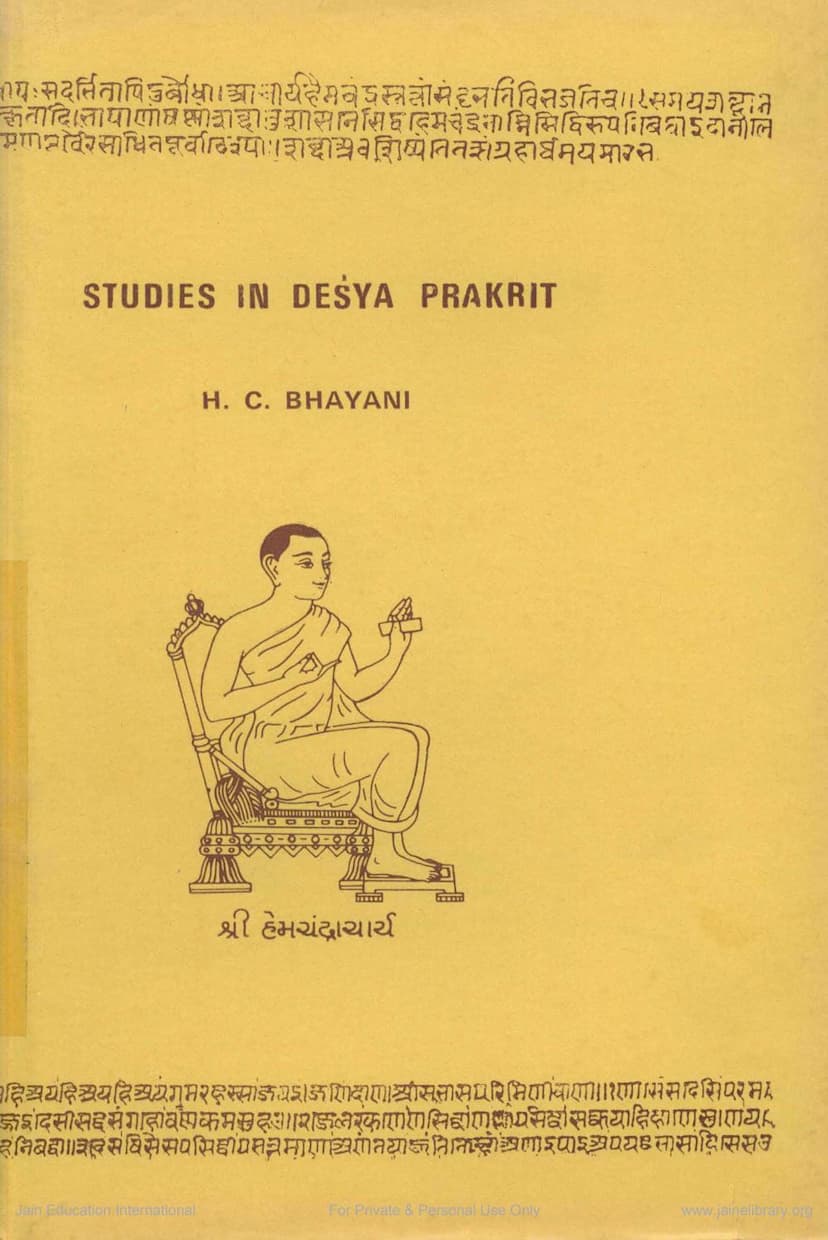Studies In Desya Prakrit
Added to library: September 2, 2025

Summary
Here's a comprehensive summary of the Jain text "Studies in Desya Prakrit" by H. C. Bhayani, based on the provided pages:
Book Title: Studies in Desya Prakrit Author: H. C. Bhayani Publisher: Kalikalasarvajna Sri Hemacandracarya Navam Janmasatabdi Smrti Siksan Samskar Nidhi, Ahmedabad Publication Year: 1988
Overall Scope and Significance:
"Studies in Desya Prakrit" is a collection of scholarly writings by H. C. Bhayani, a renowned linguist and researcher of Prakrit, Apabhramsa, and related languages. The book focuses on Desya Prakrit words, a notoriously difficult area for students of Indo-Aryan languages. These are words in Prakrit that cannot be easily derived from Sanskrit through standard phonological and grammatical rules.
The work acknowledges the pioneering efforts of scholars like Pischel but notes a subsequent decline in interest in Desya studies, which often devolved into mere data collection from individual texts. Bhayani's collection aims to reinvigorate the field by examining critical issues and problems related to Hemacandra's Deśināmamālā (a key lexicon of Desya words) and Desya words in general. It delves into their character, formation, role, and history for the first time in a comprehensive manner.
A significant aspect of Bhayani's contribution is the re-evaluation of what constitutes a "Desya" word, proposing a broader definition that might include later Sanskritizations, back-formations based on Prakrit and Apabhramśa, and even some Late Sanskrit words. He believes this expansion is necessary due to the inherent difficulty in adhering to rigid definitions and feels Hemacandra himself would have appreciated this liberal approach, given the scientific yet practical nature of his Deśināmamālā. The book aims to break new ground and open new directions for Desya studies.
Key Themes and Content Areas:
The book is structured around several key areas of investigation into Desya Prakrit:
- Hemacandra's Deśināmamālā: This work is central to the book. Bhayani examines its importance, Hemacandra's rationale for compiling it, his methodology, and the challenges he faced. He highlights Hemacandra's systematic approach to collecting and organizing Desya words, including his criteria for defining them.
- Nature and Classification of Desya Prakrit Words: Bhayani discusses the traditional classification of Prakrit words into Tatsama, Tadbhava, and Desya, and explores the nuances and complexities of the Desya category. He touches upon the linguistic characteristics and the difficulties in identifying their origins, suggesting that some might originate from Old Indo-Aryan material not attested in known literature, or even from Dravidian or other language families.
- Formal and Phonological Variation: A significant portion of the book is dedicated to analyzing the formal variations found in Desya words within Deśināmamālā. This includes:
- Graphic Variation: Errors introduced by scribes due to confusion of letters (e.g., च् / व्, च्छ / थ्य, श् / स्, ड् / ण्, म् / ण्, etc.).
- Phonological Variation: Changes resulting from natural sound developments in Middle Indo-Aryan, such as variations in vowels, consonant clusters, aspiration, voicing, assimilation, metathesis, and haplology.
- Correction of Erroneous Interpretations: Bhayani critically re-examines interpretations of Desya words given by earlier scholars (particularly Ramanujaswami) and offers his own corrected meanings, often with detailed etymological and contextual discussions. This section highlights the intricacies of understanding the intended meanings of these words.
- Specific Desya Word Studies: The book includes detailed studies of individual Desya words, analyzing their forms, meanings, origins, and variations. These are often presented with citations from various Prakrit and Apabhramśa texts.
- Importance of Jain Literature: A dedicated section emphasizes the immense value of Jain literature (canonical texts, commentaries, narrative works like Vasudevahindi and Kuvalayamālā, and Prabandhas) for understanding Desya Prakrit. This literature, with its liberal use of vernacular and non-Sanskritic elements, serves as an invaluable source for this field of study.
- Linguistic Peculiarities of Jain Sanskrit: Bhayani also touches upon the linguistic characteristics of Jain Sanskrit found in works like Jinaratna's Lilavati-sāra, noting the influence of spoken dialects, the use of technical Jain terms, and the tendency towards Sanskritization of Prakrit elements.
- Analysis of Gitālankāra's Bhāṣā-lakṣaṇa Chapter: A substantial part of the work involves a critical examination and attempted reconstruction of the Prakrit dialect names and their illustrative verses from the Gitālankāra, highlighting the corrupt nature of the manuscript and offering scholarly insights into possible original readings and meanings.
- Stray Words and Etymological Investigations: The book also includes studies on individual words where their meaning or origin is particularly obscure or debated, such as ūvvitha-, ūsurusumbhia-, thuḍumkia-, and dviraṭikā.
Key Contributions:
- Broadening the Definition of Desya: Bhayani advocates for a more inclusive definition of Desya words, acknowledging the challenges of rigid categorization.
- Systematic Analysis of Variation: The book provides a detailed and systematic analysis of both graphic and phonological variations within Desya words, which is crucial for their accurate identification.
- Critical Re-evaluation: It offers corrections to previous scholarly interpretations, enhancing the understanding of specific Desya words.
- Highlighting Jain Literature's Role: It underscores the untapped potential of Jain literature as a rich source for Desya Prakrit research.
- Methodological Innovation: Bhayani demonstrates a rigorous approach to textual criticism and etymological investigation, using comparative data from various Prakrit, Apabhramśa, and New Indo-Aryan sources.
In essence, "Studies in Desya Prakrit" is a seminal work that significantly advances the study of Desya Prakrit by meticulously analyzing a vast body of material, proposing new interpretations, and highlighting the crucial role of Jain literature in this field. It serves as a foundational text for future research in the area.